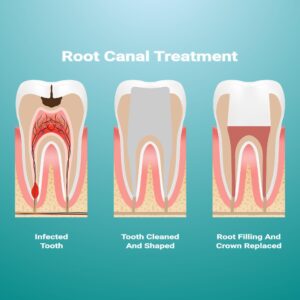Root canal treatment, or endodontic therapy, is a dental procedure to address various dental issues. If the pulp, which is the soft tissue inside the tooth, becomes infected, inflamed, or damaged, it can cause severe pain and sensitivity. In such cases, root canal treatment may be necessary to alleviate the pain and restore the tooth’s function. Root canal treatment is a highly effective way to save a damaged or infected tooth. It can prevent tooth extraction, which can cause additional problems such as shifting adjacent teeth and changes to bite alignment. With proper care, a tooth that has undergone root canal treatment can last a lifetime.
Understanding Root Canal Causes
Dental Decay and Cavities:
One of the primary causes of root canal treatment is dental decay and cavities. When tooth decay progresses, it can reach the inner pulp, leading to infection and discomfort.
Infection and Inflammation
Infections resulting from untreated cavities or dental trauma can cause inflammation in the pulp. This inflammation can be painful and may necessitate a root canal procedure.
Trauma to the Tooth
Accidents or trauma to the tooth, such as a crack or fracture, can expose the pulp to bacteria, leading to infection. Root canal treatment becomes crucial in such cases.
Signs and Symptoms
Toothache and Sensitivity
A common symptom is persistent toothache, especially when chewing or applying pressure. Increased sensitivity to hot or cold temperatures can also indicate the need for a root canal.
Swelling and Tenderness
Swelling and tenderness in the gums around a specific tooth suggest possible infection. This is often accompanied by redness and discomfort.
Discoloration of the Tooth
A change in the colour of the affected tooth, typically appearing darker than the surrounding teeth, may signal pulp damage, necessitating root canal therapy.
Diagnosis Process
Diagnosing the need for a root canal involves a comprehensive dental examination, including X-rays and a detailed assessment of symptoms. The dentist will evaluate the extent of pulp damage and determine the best course of action.
The Painless Root Canal Procedure
It is a common misconception that modern root canal procedures are painful. In reality, they are virtually painless. Dentists use local anesthesia to numb the affected area, ensuring patients are comfortable.
Initial Assessment
The dentist conducts a thorough examination, including X-rays, to assess the extent of the damage and determine if a root canal is necessary.
Anesthesia and Isolation
Patients are administered local anesthesia to ensure a painless experience. The affected tooth is isolated to maintain a sterile environment.
Removal of Infected Pulp
After numbing the area and ensuring patient comfort, the dentist will open the tooth to access the pulp. The damaged or infected pulp is then removed using specialised tools.
Cleaning and Shaping the Canal
The dentist thoroughly cleans and shapes the root canal to remove any remaining debris or bacteria. This step is essential for preventing reinfection.
Filling and Sealing
The cleaned canal is filled with a biocompatible material, typically gutta-percha and sealed to prevent further infection.
Restoration of the Tooth
The opening in the tooth is then sealed with A crown or filling to restore its function and appearance.

Advanced Technology in Root Canal
Advancements in dental technology have significantly improved the precision and efficiency of root canal procedures.
Laser-Assisted Root Canal
Laser technology is now employed in some root canal treatments, offering a more precise and less invasive approach.
Rotary Instruments for Precision
Modern rotary instruments allow dentists to shape the root canal more efficiently, reducing the time required for the procedure.
Digital Imaging for Accurate Diagnosis
Digital imaging techniques provide detailed images, aiding dentists in accurately diagnosing and treating root canal issues.
Benefits of Root Canal Treatment
Preservation of Natural Tooth
One key benefit of root canal treatment is the preservation of the natural tooth. Unlike extraction, which removes the entire tooth, root canal therapy allows patients to keep their natural teeth.
Elimination of Pain and Discomfort
Root canal treatment effectively eliminates the pain and discomfort associated with infected pulp. Once the procedure is complete, patients experience relief from toothache and sensitivity.
Restoration of Oral Health
Root canal treatment addresses the underlying infection and contributes to the overall restoration of oral health. It also prevents the spread of infection to surrounding tissues and structures.
Choosing the Right Dental Professional
Selecting an experienced and skilled dentist is essential for a successful root canal treatment.
Importance of an Experienced Dentist
An experienced dentist ensures the accuracy and efficiency of the procedure, minimising the risk of complications.
Seeking Referrals and Reviews
When considering root canal treatment, seeking referrals from friends, family, or colleagues and reading online reviews can help you choose a reliable dental professional.
Considering Modern Techniques
Dentists employing modern techniques and staying updated on advancements in endodontics can provide patients with the best possible care.

Cost Considerations
Understanding the factors influencing the cost of root canal treatment is essential for making informed decisions.
- The complexity of the case, the location of the tooth, and the need for additional procedures can influence the overall cost of root canal treatment.
- Checking with dental insurance providers to understand coverage for root canal procedures can help patients manage costs.
- Discussing affordable alternatives and payment plans with the dentist can make root canal treatment more accessible for budget-conscious patients.
Preventing Future Root Canal Issues
Taking proactive measures to prevent dental problems can reduce the likelihood of needing a root canal.
Regular Dental Check-Ups
Routine dental check-ups enable early detection of dental issues, preventing them from escalating to the point of requiring a root canal.
Maintaining Good Oral Hygiene
Practising good oral hygiene at home, including proper brushing and flossing, is crucial in preventing tooth decay and infections.
Addressing Dental Problems Promptly
Addressing dental issues promptly, such as cavities or fractures, can prevent the progression of damage to the pulp, reducing the likelihood of needing a root canal.
Conclusion
Understanding the reasons for requiring root canal treatment and its painless process is important for making informed decisions about oral health. Selecting the appropriate dental professional, following proper aftercare, and dispelling misconceptions can all contribute to a pleasant experience and ensure long-term oral well-being.


